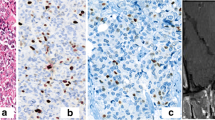Summary
Pituitary adenomas generally are regarded as benign tumours, but a part of them can invade the cavernous sinus and recur. We examined 43 pituitary adenomas for the following factors: tumour volume, endocrinological function, cavernous sinus invasion, and growth rates examined by using anti-proliferating cell nuclear antigen (PCNA) and MIB1 (a novel anti-Ki-67) as markers.
There was significant correlation between PCNA- and MIB1-positive cell rates and PCNA- and MIB1-positive cell rates were higher in the three cases with rapid regrowth than in the other cases. Staining was stronger and more distinct for MIB1 than for anti-PCNA; thus, MIB1-positive cells were easily distinguished by their intense immunoreactivity. MIB1 may be useful for detecting those rare cases with rapid regrowth even when initially regarded as benign tumours.
Adenomas with cavernous sinus invasion were significantly larger than those demonstrating no invasion. However, no significant difference was found in the frequency of PCNA- or MIB1-positive cells between adenomas with and without cavernous sinus invasion.
These findings suggest that cavernous sinus invasion and growth rate are independent biological factors. Therefore, cavernous sinus invasion may be due to chemical factors produced by the tumour itself rather than as a result of rapid tumour growth.
Similar content being viewed by others
References
Cattoretti G, Becker MHG, Key G, Duchrow M, Schlüter C, Galle J, Gerdes J (1992) Monoclonal antibodies against recombinant parts of the Ki-67 antigen (MIB1 and MIB3) detect proliferating cells in microwave-processed formalin-fixed sections. J Pathol 168: 357–363
Chan PK, Frankes R, Tan EM, Brattain MG, Smetana K, Busch H (1983) Indirect immunofluorescence studies of proliferating cell nuclear antigen in nucleoli of human tumor and normal tissues. Cancer Res 43: 3770–3777
Coudwell WT, Weiss MH (1991) Strategies for the management of nonfunctioning pituitary adenomas. In: Cooper PR (ed) Contemporary diagnosis and management of pituitary adenomas. American Association of Neurological Surgeons, Illinois, pp 29–35
Gerdes J, Schwab U, Lemke H, Stein H (1983) Production of a mouse monoclonal antibody reactive with a human nuclear antigen associated with cell proliferation. Int J Cancer 31: 13–30
Gerdes J, Lemke H, Baisch H, Wacker HH, Schwab U, Stein H (1984 a) Cell cycle analysis of a cell proliferation associated human nuclear antigen defined by the monoclonal antibody Ki-67. J Immunol 133: 1710–1715
Henke RP, Krüger E, Ayhan N, Hübner D, Hammerer P (1993) Numerical chromosomal aberrations in prostate cancer: correlation with morphology and cell kinetics. Virchows Arch A Pathol Anat 422: 61–66
Hsu DW, Hakim F, Biller BMK, Monte S, Zervas NT, Klibanski A, Hedley-Whyte ET (1993) Significance of proliferating cell nuclear antigen index in predicting pituitary adenoma recurrence. J Neurosurg 78: 753–761
Hsu SM, Raine C, Fanger H (1981) Use of avidin-biotin-peroxidase complex (ABC) in immunoperoxidase techniques: a comparison between ABC and unlabelled antibody (PAP) procedures. J Histochem Cytochem 29: 577–580
Key G, Becker MGH, Baron B, Duchrow M, Schlüter C, Flad HD, Gerdes J (1993) New Ki-67-equivalent murine monoclonal antibodies (MIB1-3) generated against bacterially expressed parts of the Ki-67 cDNA containing three 62 base pair repetitive elements encoding for the Ki-67 epitope. Lab Invest 68: 629–636
Kitz K, Knosp E, Koos WT, Korn A (1991) Proliferation in pituitary adenomas: measurement by MAb KI 67. Acta Neurochir (Wien) [Suppl] 53: 60–64
Landolt AM, Shibata T, Kleihues P (1987) Growth rate of human pituitary adenomas. J Neurosurg 67: 803–806
Miller DC (1991) Histopathologic evaluation of pituitary tumors: help for the clinician. In: Cooper PR (ed) Contemporary diagnosis and management of pituitary adenomas. American Association of Neurological Surgeons, Illinois, pp 37–45
Miyachi K, Frizler MJ, Tan EM (1978) Autoantibody to a nuclear antigen in proliferating cells. J Immunol 121: 2228–2234
Scheithauer BW, Kovacs KT, Laws ER Jr, Randall RV (1986) Pathology of invasive pituitary tumors with special reference to functional classification. J Neurosurg 65: 733–744
Selman RW, Laws ER Jr, Scheithauer BW, Carpenter SM (1986) The occurrence of dural invasion in pituitary adenomas. J Neurosurg 64: 402–407
Shi SR, Key ME, Kalra KL (1991) Antigen retrieval in formalin-fixed, paraffin-embedded tissues: an enhancement method for immunohistochemical staining based on microwave oven heating of tissue sections. J Histochem Cytochem 39: 741–748
Shibuya M, Saito F, Davis RL, Wilson CB, Hoshino T (1992) Histochemical study of pituitary adenomas with Ki-67 and anti-DNA polymerase a monoclonal antibodies, bromo-deoxyuridine labeling, and nucleolar organizer region counts. Acta Neuropathol 84: 178–183
Takasaki Y, Deng JS, Tan EM (1981) A nuclear antigen associated with cell proliferation and blast transformation. J Exp Med 154: 1899–1909
Author information
Authors and Affiliations
Rights and permissions
About this article
Cite this article
Kawamoto, H., Uozumi, T., Kawamoto, K. et al. Analysis of the growth rate and cavernous sinus invasion of pituitary adenomas. Acta neurochir 136, 37–43 (1995). https://doi.org/10.1007/BF01411433
Issue Date:
DOI: https://doi.org/10.1007/BF01411433




